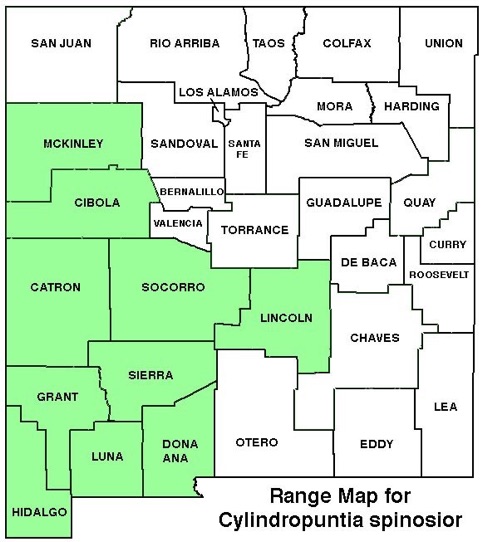WILDFLOWERS OF NEW MEXICO

Cylindrical green to purplish stem segments form a bushy to tree-like clump 1–6 feet tall and wide. Each cylindrical segment is 2–9 inches long (5–23 cm), 1/2–1 3/8 inches diameter (1.3–3.5 cm), and lined with tubercles 3/8–5/8 inch long (9–15 mm), each with an areole clustered with spreading, whitish spines. Note the flowers have rose to purplish tepals (petals) with magenta filaments and yellow anthers, and the fleshy fruit is bright yellow and spineless, but with glochid bristles.
FLOWER: April–August. Numerous showy, cup-shaped to spreading flowers to 3 inches wide (7.5 cm); petal-like tepals usually rose to bronze, though sometimes yellow, greenish, or white; filaments deep-purple to pink; anthers yellow, stigma lobes creamy-yellow. Fruit bright yellow to reddish tinged, barrel-shaped, 1–1 3/4 inches long (2.5–4.5 cm), tubercles spineless but with glochid bristles; remains on plant through winter.
SPINES: Each areole bears 6–18 spreading, often interlacing spines, 1/4–3/4 inch long (8–19 mm), pale-tan covered with a white sheath; glochids barbed, bristle-like, 1–2 mm long in a tuft at base of spines.
HABITAT: Dry, sandy, loamy, gravelly soils; dry washes, plains, hills; desert grasslands and scrub, ponderosa, pinyon-juniper woodlands.
ELEVATION: 4,526–6,450 feet.
RANGE: AZ, NM; Mexico. Chihuahua and Sonora deserts.
SIMILAR SPECIES: The nearly statewide Cane Cholla, C. imbricata, has 3/4–1 1/4-inch diameter (20–32 mm) stems, magenta flowers, and yellow fruit. has 3/4–1 1/4-inch diameter (20–32 mm) stems, magenta flowers, and yellow fruit. Whipple’s Cholla, C. whipplei, in the western half of NM, has thinner stems, 1/4–5/8 inches diameter (5-15 mm), and yellow flowers. Walkingstick Cholla hybridizes with other Cylindropuntia within its range resulting in individuals with mixed features. Flora Neomexicana III (Allred, 2020) lists the species as C. imbricata var. spinosior.
NM COUNTIES: Southwestern NM in low-elevation, desert habitats: Catron, Cibola, Dona Ana, Grant, Hidalgo, Lincoln, Luna, McKinley, Sierra, Socorro.

WALKINGSTICK CHOLLA
CYLINDROPUNTIA SPINOSIOR (Cylindropuntia imbricata var. spinosior, Opunia spinosior)
Cactus Family, Cactaceae
Perennial cactus



THE CONTENTS OF THIS WEBSITE ARE COPYRIGHTED AND CANNOT BE USED
WITHOUT PERMISSION OF GEORGE OXFORD MILLER
EMAIL ME
Filaments are purple (top arrow), the anthers yellow (middle arrow), and the stigma is creamy-yellow (lower arrow).





• The fruit are yellow and spineless.
• The tubercles on the stem joints have 6–18 whitish spines (arrow).

Walkingstick Cholla with Mexican Poppies (Eschscholzia californica), Florida Mountains, Luna County.
Desert birds, such as curved-bill thrashers and cactus wrens, build nests protected in the spiny branches of cholla cacti.
